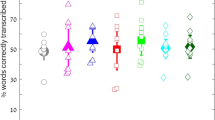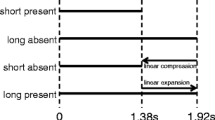Conclusions
Reading practice with accompanying compressed speech as a pacer resulted in a significantly greater increase in reading rate without an accompanying loss in comprehension for the experimental group when compared with the control group. Scores on the delayed posttest seemed to indicate that the increase in reading rate was more than temporary.
The significant increase in reading rate was accomplished with only 10 practice sessions. The number of sessions in earlier studies using pacers ranged from 16 (Marvel, 1959) to 50 (Wilson & Leavell, 1956). The present study suggests that a smaller number of sessions using compressed speech as a pacer can be effective in increasing reading rate.
Since there was no significant difference between gain scores for the experimental and control groups for listening, this study provided no evidence to support the use of practice with compressed speech to improve listening ability. It might be noted however that the training sessions consisted of reading short storieswhile listening to the compressed speech. Thus, subjects did not receive practice in which listening to compressed speech was the sole activity. It is perhaps for this reason that the experimental group did not improve more in listening than did the control group.
Similar content being viewed by others
References
Bish, C. E. An experiment in reading improvement.National Association of Secondary School Principals, 1952,36, 89–96.
Blubaugh, J. A.An experimental study of the effects of information, instruction and motivation on listening behavior. Unpublished masteŕs thesis, University of Kansas, 1963.
Brim, B. J. Impact of a reading improvement program.The Journal of Educational Research, 1968,62, 177–181.
Brown, J. I. Teaching listening through listening-type tests.College English, 1952,13, 224–225.
Brown, J. I. Can listening be taught?College English, 1954,15, 290–291.(a)
Brown, J. I. How teachable is listening?Educational Research Bulletin, 1954,33, 85–93.(b)
Brown, J. I., & Carlsen, R. G.Brown-Carlsen Listening Comprehension Test, Revised Edition. Yonkers, New York: World Book Co., 1955.
Canfield, G. R.A study of the effects of two types of instruction on the listening comprehension of fifth grade children. Unpublished doctoral dissertation, Syracuse University, 1960.
Cosper, R. & Kephart, N. C. Retention of reading skills.Journal of Educational Research, 1955,49, 2211–2216.
Dumler, M. J. Study of factors related to gains in the reading rate of college students trained with the tachistoscope and accelerator.Journal of Educational Research, 1958,52, 27–30.
Elliff, G. A direct approach to the study of listening.English Journal, 1957,46, 20–27.
Flesch, R.How to Test Readability. New York: Harper, 1951.
Gallant, R.The improvement of listening comprehension skills at the college level. Unpublished masteŕs thesis, Miami University of Ohio, 1959.
Hollingsworth, P. M. Effectiveness of a course in listening improvement for adults.Journal of Communication, 1966,16, 189–191.
Hollow, M. K. An experimental study of listening comprehension at the intermediate grade level. In S. Duker (Ed.),Listening: Readings. Metuchen, N. J.: Scarecrow Press, 1966. Pp. 219–225.
Irvin, C. E. Report of NSSC listening committee.Journal of Communication, 1951,1, 66–69.
Kelly, C. M. An investigation of the construct validity of two commercially published listening tests.Speech Monographs, 1965,32, 139–143.
Loban, W. & Olmsted, R. A. (Eds.)Adventures in appreciation. Vol. 1. New York: Harcourt, Brace, and World, 1963.
Marvel, J. A. Acquisition and retention of reading performance on two response dimensions as related to “ “set” and tachistoscope training.Journal of Educational Research, 1959,52, 232–237.
Maxwell, M. J., & Horn, A. Acomparison of two methods for increasing reading speed with the reading accelerator.Journal of the Reading Specialist, 1966, 5,113–117.
NEA Research Bulletin. Highschool drop outs, February, 1960,38, whole issue.
Nelson, M. J., & Denny, E. C.The Nelson-Denny reading test, revised by James I. Brown. Boston: Houghton Mifflin, 1960.
Nikas, G. B. A study of teacher-oriented versus machine-oriented developmental reading classes at the college level.Journal of Reading, 1965,8, 214–216.
Orr, D. B. Recent research on reading and the comprehension of time-compressed speech.College Reading Association: Proceedings (Easton, Pennsylvania), 1966, 7, 79–84.
Poulton, E. C. British courses for adults on effective reading.British Journal of Educational Psychology, 1961,31, 128–137.
Smiley, M. B., Spiegler, C. G., Marcatante, J. J., & Jacqueline, T. (Eds.)Striving. New York: Macmillan, 1967.
Smith, P., & Tate, T. R. Improvements in reading rate and comprehension of subjects training with the tachistoscope.Journal of Educational Psychology, 1953,44,176–184.
Wedeen, S. U. Mechanical versus non-mechanical reading techniques for college freshmen.School and Society, 1954,79, 121–123.
Wilson, G. E., & Leavell, U. W. An experiment with accelerator training.Peabody Journal of Education, 1956,34, 9–19.
Author information
Authors and Affiliations
Additional information
This article is based in part on Thameśs masteŕs thesis which was completed at the University of Wisconsin-Milwaukee.
Rights and permissions
About this article
Cite this article
Thames, K.H., Rossiter, C.M. The effects of reading practice with compressed speech on reading rate and listening comprehension. ECTJ 20, 35–42 (1972). https://doi.org/10.1007/BF02768387
Issue Date:
DOI: https://doi.org/10.1007/BF02768387




